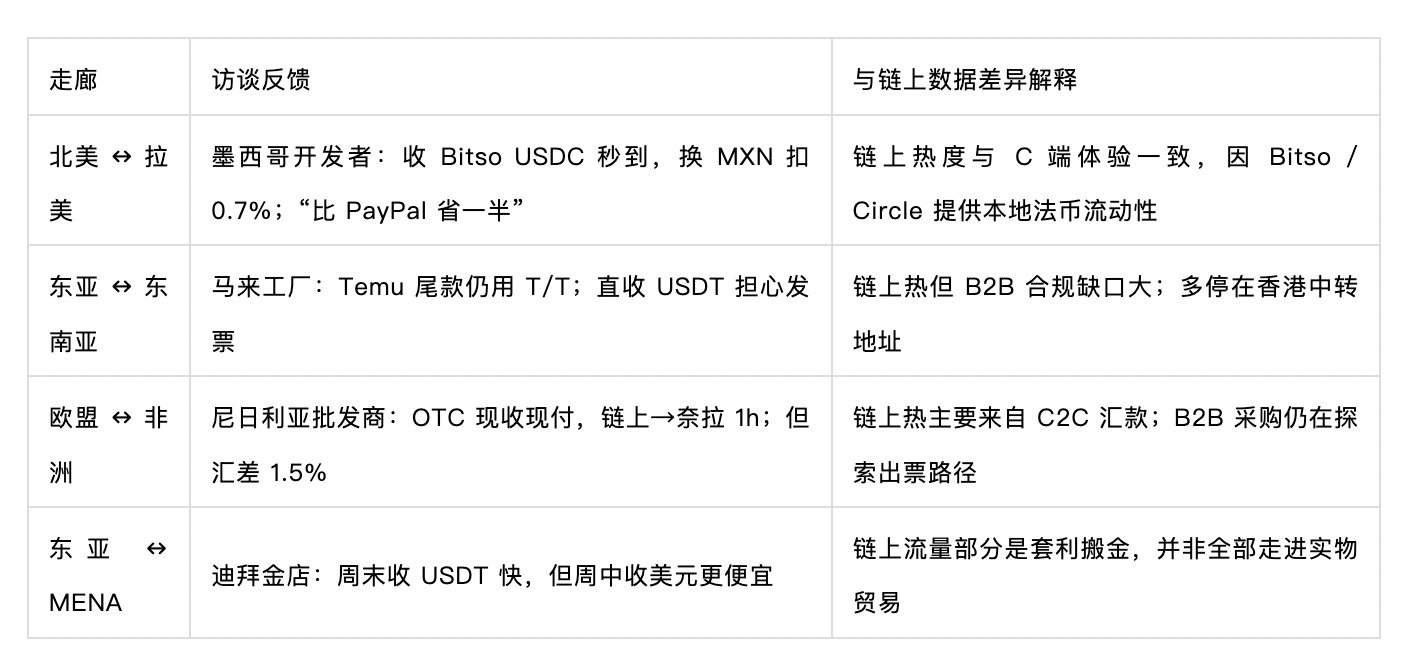Author: Stablecoin Payment · Evangelism
Recently, I conducted a "field study," communicating with frontline traders from China's small commodity markets to the gold trading hub of Shenzhen Shuibei, both online and offline. I want to discuss with everyone—how far have stablecoins come in real-world cross-border settlements?
- What is a stablecoin: Stablecoin 101: Is 1 USDT ≈ 1 USD?
- In a nutshell: A stablecoin is a "fiat currency voucher on the blockchain" (the US dollar is the most mainstream, but versions in HKD, EUR, and other currencies are also growing rapidly), with the mainstream duopoly USDT / USDC accounting for over 85% of global circulation.
USDT (Tether)
: With a market cap exceeding $80 billion, it occupies the market due to early first-mover advantage, mainly used in cryptocurrency trading and cross-border private settlements, but its reserve transparency is often questioned (for example, it was investigated by US regulators in 2021).
USDC (USD Coin) is jointly issued by Circle and Coinbase, with a market cap of about $50 billion, and has stronger compliance (monthly audits of reserves, which can only be backed by cash and government bonds). It has been accepted by institutions like JPMorgan and Goldman Sachs, and in recent years, its usage in DeFi (decentralized finance) scenarios has surpassed that of USDT.
The anchoring secret: The issuer deposits corresponding fiat currency cash, short-term government bonds, and other highly liquid assets in a custodian bank, with auditing firms providing monthly reports, theoretically allowing for 1:1 redemption.
Enterprise laboratories & pioneer cases:
Visa × Circle (USDC settlement) official press release 2023-09:
Model: Visa integrates USDC to connect traditional card networks with blockchain settlements. For example, a Canadian user can transfer USDC to Latin America, with funds cleared on-chain by Circle (based on Ethereum or Solana), and then exchanged into local fiat currency by Visa's partner banks, reducing the transaction time from the traditional 1-3 days to under 30 minutes.
2024 progress: Pilot projects in Latin America covering Brazil and Mexico, focusing on addressing the cross-border remittance needs under local high inflation (e.g., overseas workers using USDC to send money home, avoiding local currency depreciation risks).
Stripe Crypto Payouts: Launched USDC payroll solutions in April 2022, now covering freelancers in over 110 countries. • Integrated platforms: Twitter Creators, Braintrust, OpenSea, etc.
Scenario: Providing USDC payroll options for global freelancers. For example, a US company pays an Indian developer through Stripe directly in USDC, allowing the developer to exchange it for rupees at a local exchange, saving on traditional cross-border transfer SWIFT fees (about 5%-10%) and exchange rate losses.
Data: As of 2024, covering over 150 corporate clients, with a monthly settlement volume exceeding $20 million, where Southeast Asia and Africa have the highest acceptance rates among freelancers.
PayPal & Venmo — PYUSD ecosystem 2023-09: The first batch of Venmo users can buy, hold, and transfer PYUSD, with free internal transfers on PayPal in seconds. • Full rollout in 2024, supporting on-chain deposits and withdrawals (Ethereum/Solana). • In April 2025, announced a 3.7% annual reward & fee-free Xoom overseas remittances; plans to expand to Stellar. → This means stablecoins have connected the entire "wallet-consumption-remittance-earnings" chain.
Progress: Launched the dollar-pegged stablecoin PYUSD in 2023, approved by the US Office of the Comptroller of the Currency (OCC), with reserves consisting only of cash and short-term government bonds. Currently mainly used for inter-institutional settlements (e.g., hedge funds using PYUSD to pay trading commissions), with plans to open it to ordinary users for cross-border shopping in 2024.
SocGen-Forge EURCV 2024-06 received the first "EMI level" license for euro stablecoins under the EU MiCA regulation, aimed at institutional government bond & money market fund settlements.
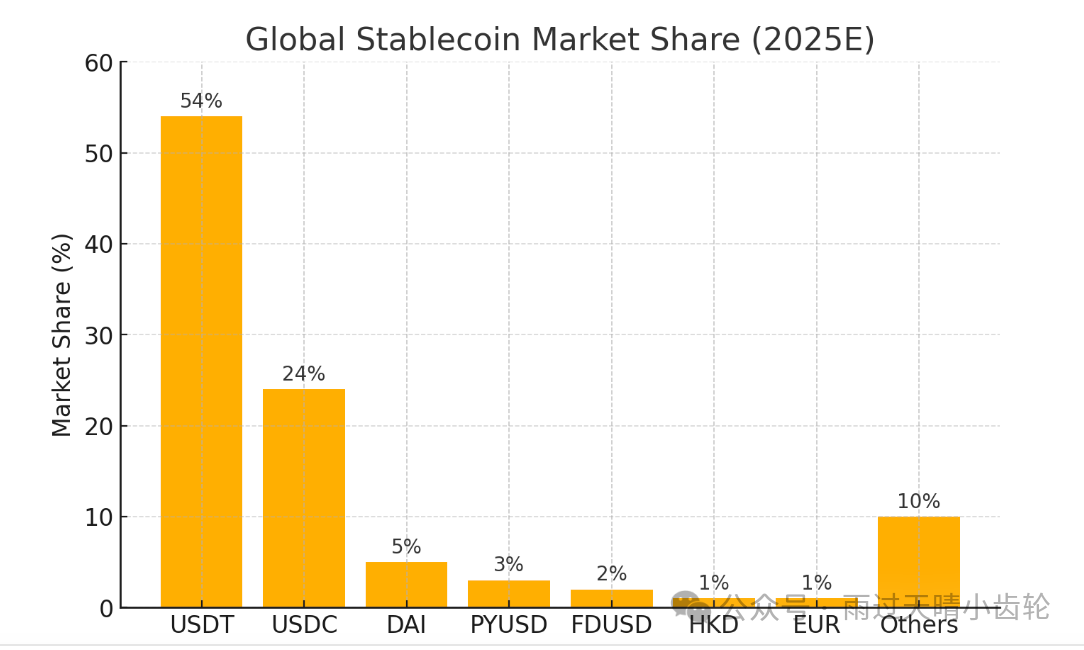
2. Why do cross-border payments need stablecoins?
First, a dialectical statement: In mainstream currency areas like Europe, the US, and Japan, Airwallex, Wise, and even SWIFT gpi can achieve USD⇋GBP transfers in 30 minutes at a cost of 0.4–1%. So what value do stablecoins still hold? Here are four "incremental scenarios."
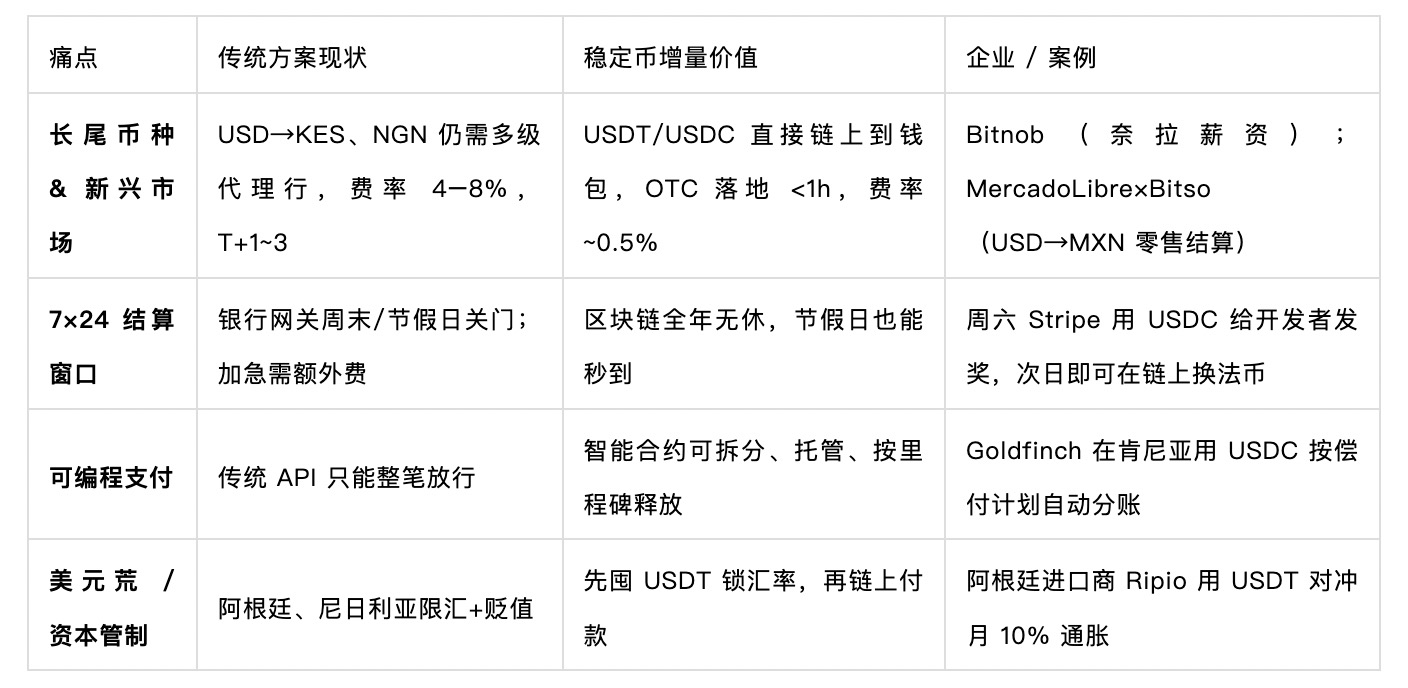
Bitnob (Africa payroll): Naira wages arrive on-chain in seconds, with employees reporting "receiving dollars feels like getting a text message," and OTC cash exchanges averaging 40 minutes.
MercadoLibre × Bitso (Latin American retail giant): Sellers can receive USDC payments in real-time even on weekends, with refund windows shortened by 1.5 days, saving $200,000 in fees monthly.
Stripe weekend bounty program: A Vietnamese developer shared—receiving 50 USDC on Saturday night, exchanging it for VND on-chain 10 minutes later, and purchasing a server that night without waiting for the bank to open on Monday.
Ripio (Argentinian importer): The owner said, "Hoarding USDT is like giving the company dollar insurance," hedging against exchange losses of over 8% last year.
Special Needs in Emerging Markets: Anti-Inflation and Payment Convenience
- The "currency substitution" demand in high-inflation countries
Example: Argentina's inflation rate exceeded 100% in 2023, and local merchants may see the peso depreciate by 5% within a day after receiving it, while receiving USDC is equivalent to "holding dollar assets," providing stronger value retention. Cross-border e-commerce sellers in Buenos Aires now require USDC for 60% of their orders.
Logic: For them, stablecoins are not just payment tools but also "anti-inflation storage means," similar to how Zimbabweans used to hoard cash in dollars, now they hoard USDT.
- Payment entry for the unbanked population
- Data: About 60% of Africa's population lacks bank accounts but has mobile wallets (like Kenya's M-Pesa). Stablecoins can facilitate cross-border payments for the unbanked through a "fiat → stablecoin → fiat" exchange chain. For example, a Nigerian farmer selling cocoa beans to a European buyer can receive USDC in their crypto wallet, which they can then exchange for naira cash locally.
On the G3 currency highway (i.e., the mature settlement channels for the three major currencies: USD, EUR, JPY), FinTech is already fast enough; however, in long-tail corridors, weekend nights, and scenarios requiring "money to move with code," stablecoins can compress time from T+1 to T+0 and reduce rates from 4% to 0.5%. They do not replace banks but fill in the blind spots and pave the "last mile."
3. On-chain toolbox: Three most common "transfer methods"
Think of them as the payment/banking tools we use every day.
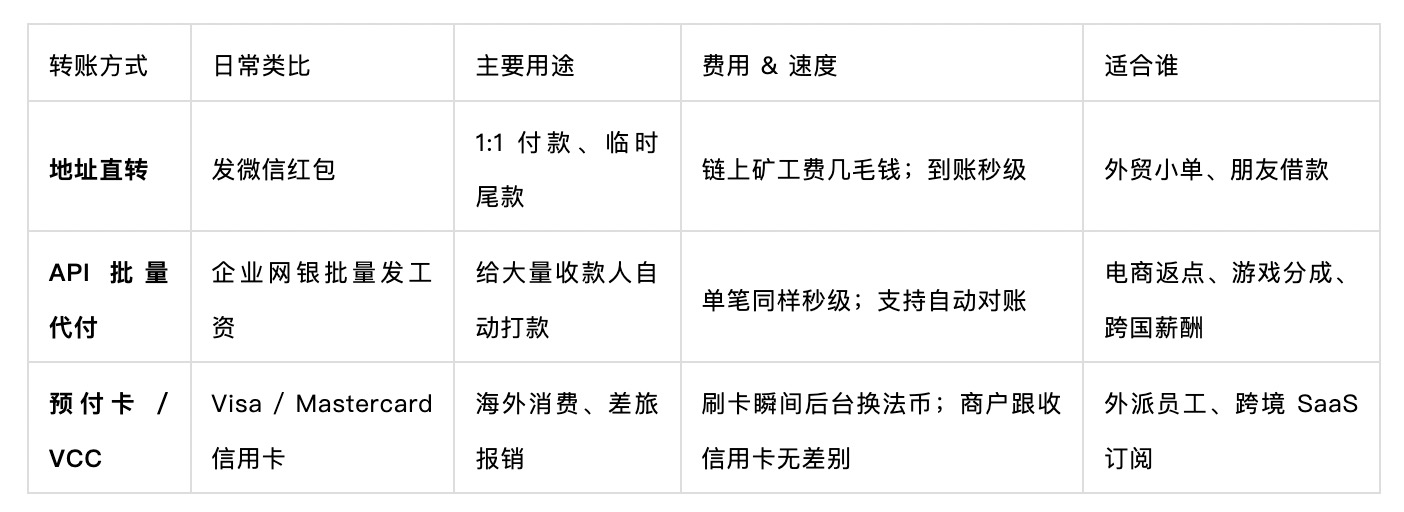
Imagine you have three keys: the red envelope key for "point-to-point" small transfers; the payroll key that can send money to hundreds or thousands of people with one click; and the credit card key that turns stablecoins on-chain into globally usable Visa/Mastercard. Choose the key based on the scenario, and on-chain payments are that simple.
4. Hot corridors: On-chain data vs. field observations
First, use the "on-chain telescope" to see which corridor is the hottest, then use the "field microscope" to hear what local merchants have to say. Data comes from Chainalysis 2024-Q3 Stablecoin Dashboard, with amounts reflecting monthly net flows aggregated across multiple chains.
4.1 Top 5 funding corridors & scenario cases

Bank settlements for G3 currencies (USD/EUR/JPY) are already fast, so on-chain traffic is mainly concentrated in corridors with "dollar shortages + high rates," especially in Latin America, Africa, and MENA.
4.2 Field observations & discrepancies
4.3 Takeaway
Money flows to the places with the most pain points: Countries that lack dollars, have high bank rates, and need weekend settlements are more inclined to use stablecoins.
On-chain volume ≠ real-world volume: It is essential to see whether liquidity bridges (OTC, compliant APIs) can turn TxID into invoices and fiat currency.
Incremental opportunities: For corridors that are "hot on-chain but cold on the ground," providing automatic reconciliation + local currency landing + compliant invoices is most likely to explode first.
5. Four typical scenario breakdowns
5.1 Small foreign trade tail payments (Yiwu)
On-chain perspective
Chainalysis 2024-Q3 custom tags ("Yiwu Commodity Market" + Zhejiang import-export clustering) show: monthly net inflow of stablecoins is about $870 million, annualized to ~10.4 billion USD, with USDT accounting for 92%.
Huatai Securities' "Yiwu Cross-Border Payment Research" (2025-06) estimates that "Yi Payment" on-chain receipts will exceed $4 billion for the entire year of 2024.
Who is using it? (Interviews + media cross-references + my field notes)

Payment circulation chain (example)
An American buyer places an order on Discord → Transfers 600 USDT (TRC20) to the address displayed by the merchant using Coinbase.
The merchant's cold wallet receives U → On weekends, converts it to USD at an OTC in Hong Kong.
Transfers to a local settlement account in Yiwu → Export receipts; due to the low amount, the customs broker accepts a screenshot of the electronic receipt + self-printed invoice.
When claiming tax refunds, uses the on-chain TxID + electronic water slip to match bank statements, with compliance difficulties currently assisted by the "Yi Payment service provider."
Limitations & Risks
High fragmentation: Transactions below $1,000 occupy on-chain traffic but contribute limited value to official foreign trade statistics.
Compliance vacuum: Bulk exports still require paper customs documents; most on-chain receipts remain in the "cash alternative" stage.
Prone to mislabeling: Some group orders or sources of infringement disrupt on-chain labels, causing data noise.
The "Three Layers of Truth" in Yiwu's Small Trade Stablecoin Usage
Data label's "regional misjudgment"
The "Yiwu commodity market" address labeled by Chainalysis actually includes: local Yiwu merchant wallets (30% share); wallets of freight forwarding companies in Shenzhen and Guangzhou (transferring funds to Yiwu after receiving goods); wallets of currency exchange intermediaries in Hong Kong (collecting USDT before converting to RMB); for example, a "Yiwu jewelry factory" address is actually a Hong Kong currency exchange dealer, collecting $50 million USDT monthly, then converting it to RMB through underground money changers, mislabeling it as "Yiwu trade settlement."
The 92% USDT share as "cost-driven"
The reason for Yiwu's preference for USDT in small orders: low fees: TRC USDT transfer fee is $0.1, suitable for orders below $500 (fee ratio of 0.02%); strong liquidity: USDT has a 3% lower premium than USDC in the African black market, making customers more willing to pay; in comparison: USDC often gets rejected for small transfers due to strict compliance checks, with USDC small transactions in Yiwu accounting for less than 5% in 2024.
The $4 billion estimated "caliber dispute": Huatai Securities' statistics on "Yi Payment on-chain receipts" include: real trade: 30%-40% (about $1.2-1.6 billion); underground currency exchange: 50%-60% (about $2-2.4 billion); arbitrage trading: 10% (about $400 million);
5.2 Platform Rebates / Profit Sharing (Cross-Border E-Commerce & Content Platforms)
Stripe Crypto Payouts: Creator rewards on Twitter (now X) and profit sharing for remote engineers on Braintrust are distributed in bulk via USDC, covering over 110 countries, with creators reporting "instant transfers even on weekends" (ankr.com).
Comparison of pain points in traditional solutions and stablecoin solutions:
Cross-border wire transfers: Paying royalties to creators in 100 countries requires handling different currency exchanges, with a single transaction fee of $5-10, taking 3 days for 1,000 transactions;
PayPal: Charges 2.9% + $0.3 per transaction, with restrictions on receiving payments in some countries (e.g., Nigeria);
Stablecoin solution: Using USDC through Stripe Crypto Payouts for bulk transfers, with a single transaction fee of $0.1, 1,000 transactions settle in 1 minute, and supports automatic revenue sharing.
Shopee Pay USDT rebate test: An internal notice on a Southeast Asian platform (in a gray area), Malaysian and Vietnamese factories can choose to receive rebates on-chain; the official rate is stated to be 0.4%, with automatic reconciliation back to ERP. (Data is not publicly available as it is still in the pilot phase.)
Business model: The Indian e-commerce platform Shoppy Pie offers rebates to Southeast Asian sellers (5% of each sale), settling in USDT in 2023: sellers bind their TRC wallet address on the platform; after confirming receipt of each order, a smart contract automatically deposits USDT into the seller's wallet; sellers can exchange it for Indonesian rupiah / Thai baht at local exchanges, saving 60% on fees compared to wire transfers;
Data comparison:
Traditional wire transfer monthly cost is $20,000, while the stablecoin solution's monthly cost is $8,000, improving efficiency by 75%.
Core Pain Points → Stablecoin Advantages: Platforms do not need to reserve liquidity for weekends; factories can receive payments daily, reducing the payment cycle from T+7 to T+0.5.
5.3 Freelance Compensation (Over 100 Countries Worldwide)
Bitwage: An American outsourcing company uses Bitwage to directly convert salaries into USDC/USDT, with programmers in the Philippines, Argentina, and Uganda receiving an average of 5% more than through PayPal.
Operational process:
A New York advertising company pays a Kenyan designer $500 USDC via Circle Pay;
After receiving USDC, the designer exchanges it for Kenyan shillings through the local exchange Luno;
The exchange cost is 0.5% (2.5% lower than PayPal), with the settlement time reduced from 3 days to 10 minutes;
Data comparison:
The traditional path's monthly cost is $2,000, while the stablecoin solution's monthly cost is $800, improving efficiency by 60%.
Chainalysis Data: In Nigeria, freelancers account for the highest proportion of $3 billion quarterly stablecoin small transactions.
Real Feedback: A Kenyan designer reports: USDC → M-Pesa settlement takes 40 minutes, with a fee of 1.5%, saving half a day of queuing for cash withdrawal.
5.4 Import Procurement Hedging (High-Inflation Countries)
Ripio & Argentinian Importers: The CEO stated that Brazilian companies use USDT to pay Chinese suppliers, avoiding the double depreciation of naira & peso; Ripio provides cross-border gateways.
Argentinian E-Retail: Under currency exchange restrictions, merchants first hoard USDT, making "instant拆" payments to Brazilian factories upon shipment; hedging against exchange losses of 8-10% over the year.
Commonality: Either pursuing "time value > transaction fees" or avoiding foreign exchange/trade compliance friction.
6. Regulatory Barometer: How are Hong Kong, the US, and Europe regulating? A Quick Reference Table + Plain Language
Stablecoin regulation is "the same topic but different papers": the three major regions have different focuses, but there are also common bottom lines.
6.1 A Quick Reference Table

6.2 Plain Language Interpretation: Using "Taxi" Metaphor
Hong Kong is like having dedicated lanes already drawn: as long as you obtain a "compliant license" (100% reserves + reports), you can directly hit the road to carry passengers (B2B / retail payments).
The US is like each state managing its own street: state governments first give you a "temporary license," but to operate nationwide, you must register in Washington; whether the bill passes or not, the lane is still being paved.
Europe is like a highway that is already open, but with speed limits: if you run over €200 million daily, you must report; first, run logistics within the Eurozone, and only when it runs smoothly will retail traffic be allowed.
Hong Kong "Dedicated Lane": License is a Pass, Can Cross Regions but Limited to Vehicle Types
- Lane Rules
Licensed vehicles (compliant stablecoins):
Must apply to the Hong Kong Monetary Authority for a "stablecoin taxi license" (e.g., Circle has obtained a license), and the vehicle (reserve funds) must park in a Hong Kong bank "parking lot";
Can carry passengers in Hong Kong's "urban area" (legal trade scenarios) and can also drive on the "cross-border highway" (e.g., USDC to RMB pilot);
Restrictions: "Black cars" (non-licensed stablecoins) are prohibited from the road; in 2024, a certain USDT "black car" gang was caught, fined HKD 20 million;
Passengers must be "professional drivers" (assets ≥ HKD 8 million), while retail investors can only sit in the "passenger seat" (indirectly using through compliant platforms).
- Driving Case
A gold merchant in Hong Kong operates a "USDC taxi":
After obtaining a license, transporting "gold orders" from Shenzhen Shuibei to Dubai, when passing through "customs checkpoints" (on-chain customs declaration), presents the Monetary Authority's "driving permit" (compliance report), reducing clearance time from 3 days to 4 hours;
In comparison to "black cars" (non-licensed USDT): the risk of being detained by customs (frozen funds) is 30% higher.
The US "State Temporary License": Need to Change License for Interstate Travel, Federal Lane Under Construction
Lane Status
* State-level lanes: New York allows "USDC ride-hailing" to operate locally (requires a state bank license), while California only permits "Circle ride-hailing" to accept orders;
Florida prohibits "algorithmic stablecoin taxis" from operating (e.g., UST-like products);
Federal lane ("Stablecoin Act"): Currently paving asphalt (in legislation), requiring vehicles (stablecoins) to add "Federal Reserve gasoline" (100% US Treasury reserves);
Once completed, "USDT trucks" will need to change to a federal license to transport goods across states (national circulation).
Driving Troubles
A certain cross-border e-commerce company in the US operates a "USDC truck":
Obtaining a temporary license in New York, can only operate on the New York - New Jersey route;
To operate in California, must apply for a license from the California Department of Motor Vehicles (state regulatory agency), incurring an additional 20% in fees;
When the federal lane is not open, interstate travel requires detours (e.g., transiting through Canada), increasing transportation costs by 30%.
Europe "Speed-Limited Highway": First Run Logistics Vehicles, Then Allow Private Cars
Lane Design
Eastern Section (Eurozone Logistics):
Allows "EUR Coin heavy trucks" to run the Berlin - Paris route, with a speed limit of 100 km/h (annual transaction volume ≤ €100 million);
Vehicles must be equipped with "EU GPS" (real-time monitoring system), reporting the cargo (reserve funds) every 2 hours;
Western Section (Retail Traffic):
Still under construction for the ramp (in pilot), planning to allow "retail cars" on the road by 2025, but must pass through the "KYC toll booth" (identity verification).
Driving Efficiency
A German car manufacturer operates "EUR Coin heavy trucks": transporting parts from Munich to Paris, the GPS automatically reports cargo (reserve funds) at the "EU checkpoint," with a clearance time of 10 minutes;
In comparison to "USD trucks": traveling via SWIFT highway takes 3 days, with toll fees (transaction fees) 50% higher;
Restrictions: Cannot exceed speed limits (over €100 million in transaction volume), or risk being towed (regulatory sandbox review).
Global "Cross-Border Intersection" Customs Clearance Challenges
US-EU Border: American "USDC trucks" entering Europe must exchange for "EUR Coin license plates" (asset conversion), with a transaction fee of 2% and a 1-day wait (regulatory review);
China-US Border: Hong Kong "USDC taxis" entering the mainland can only use the "Free Trade Zone dedicated lane" (Zhejiang pilot), and passengers (businesses) must have a "whitelist pass" (pilot qualification);
African Backroads: Few formal lanes, "USDT taxis" are everywhere, flexible but prone to "regulatory bandits" (account freezes), with Nigeria seizing 300 "black taxis" in 2024.
Advice for Trade Drivers: Choose the Road and Vehicle
Short-distance urgent orders (e.g., Yiwu - Africa small orders):
Choose Hong Kong "USDC taxis": dedicated lanes are fast, licensed and compliant, suitable for orders under $50,000;
Interstate Long-Distance (e.g., US - Europe trade):
After the US federal lane opens, switch to "USDC federal trucks," but for now, use European "EUR Coin heavy trucks" for transit;
High-risk routes (e.g., Argentine imports):
Temporarily use "USDT taxis" (non-compliant), but remember to bring "agent currency exchange navigation" (to avoid regulation), waiting for the Hong Kong lane to extend there in the future.
6.3 Corresponding "Landing Postures" at Different Stages
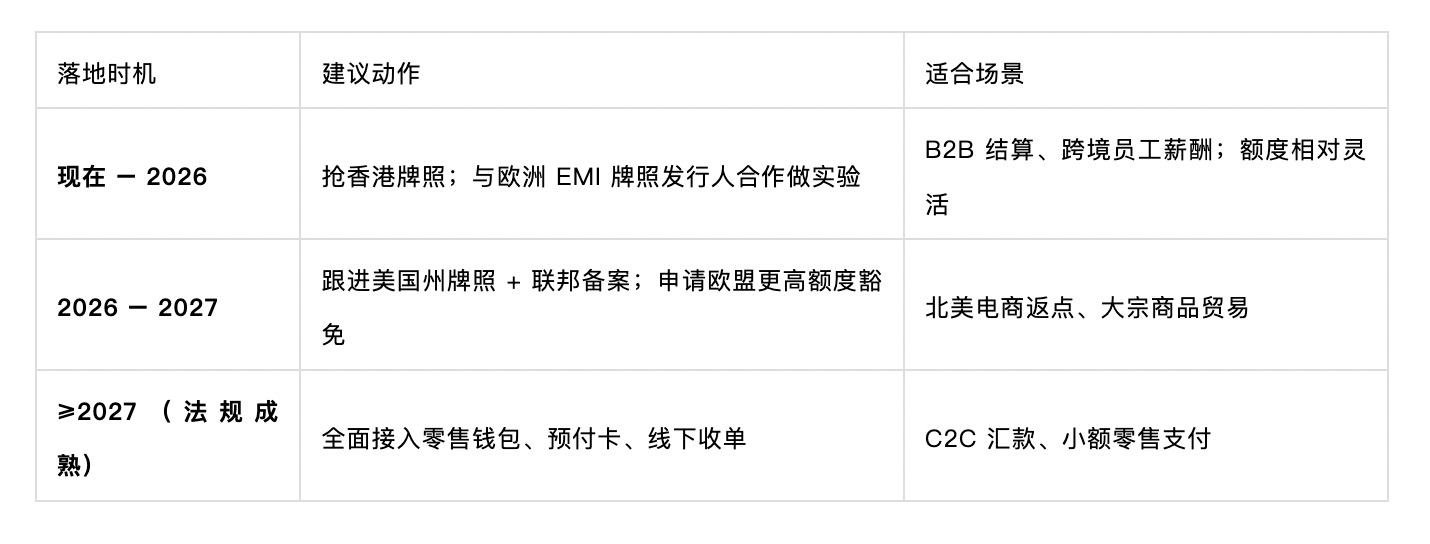
Summary in One Sentence
"All three regions insist on '100% reserves + real-time disclosure,' but the lane widths differ. Hong Kong has paved the lane waiting for you to start; Europe has set speed limits to get moving; the US is still constructing the elevated road. Companies should first pilot in Hong Kong/EU, and once the US legislation is in place, expand at full speed."
7. Risks, Misconceptions, and Next Opportunities
7.1 Common Risks & Misconceptions

Stablecoins are like "high-speed express trains," saving time and money, but the road signs, speed limits, and ticket checks are still being upgraded. Start with a small vehicle to familiarize yourself with the rules before driving a bus at full speed.
"The $1 billion on-chain flow I see may not all be within a formal compliance framework; however, every demand for 'instant settlement, low cost, and global access' is pushing the evolution of payment infrastructure. The day compliance is fully operational will be the true market explosion point."
免责声明:本文章仅代表作者个人观点,不代表本平台的立场和观点。本文章仅供信息分享,不构成对任何人的任何投资建议。用户与作者之间的任何争议,与本平台无关。如网页中刊载的文章或图片涉及侵权,请提供相关的权利证明和身份证明发送邮件到support@aicoin.com,本平台相关工作人员将会进行核查。
